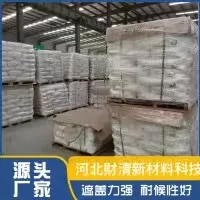
Sep . 02, 2025 09:11 Back to list
How Titanium Dioxide Enhances UV Resistance in Exterior Wall Coatings
Titanium dioxide (TiO₂) is a versatile and widely used material in various industries, particularly in coatings and paints. One of its most significant applications is in exterior wall coatings, where it plays a crucial role in enhancing UV resistance. This article explores how titanium dioxide powder contributes to the durability and longevity of exterior coatings by protecting against ultraviolet (UV) radiation. We will also discuss the types of titanium dioxide, its manufacture process, its role as a titanium dioxide pigment, and factors influencing titanium dioxide price.
The Role of Titanium Dioxide in UV Protection
Exterior wall coatings are constantly exposed to sunlight, which contains harmful UV rays. Over time, UV radiation can degrade the binder systems in paints, leading to fading, chalking, and loss of adhesion. Titanium dioxide pigment acts as a UV absorber and reflector, shielding the coating from these damaging effects.
There are two primary types of titanium dioxide used in coatings:
Rutile TiO₂ – Known for its superior UV resistance and high refractive index, making it ideal for exterior applications.
Anatase TiO₂ – Less stable under UV exposure but sometimes used for specific aesthetic effects due to its slightly different titanium dioxide color.
By scattering and absorbing UV light, TiO₂ minimizes photochemical degradation, ensuring that the coating remains intact and visually appealing for years.

Titanium Dioxide Manufacture and Its Impact on Performance
The manufacture of titanium dioxide involves two main processes: the sulfate process and the chloride process. Both methods produce high-purity titanium dioxide powder, but the chloride process is more common for rutile TiO₂ due to its efficiency and lower environmental impact.
The quality of TiO₂ significantly affects its performance in coatings. Finely milled particles with optimal surface treatments enhance dispersion, ensuring uniform UV protection across the coating film. Poorly manufactured TiO₂ may lead to uneven protection, reducing the coating's lifespan.
Titanium Dioxide Pigment: More Than Just a Whitening Agent
While TiO₂ is widely recognized for its brilliant white titanium dioxide color, its functionality extends far beyond aesthetics. As a titanium dioxide pigment, it provides:
Opacity – By scattering visible light, TiO₂ ensures strong coverage, reducing the need for multiple coats.
Photocatalytic Resistance – Advanced TiO₂ variants are treated to minimize photocatalytic activity, which can otherwise degrade organic binders in paint.
Chemical Stability – TiO₂ does not react with other coating components, ensuring long-term performance.
These properties make it indispensable in high-quality exterior coatings designed to withstand harsh weather conditions.
Factors Affecting Titanium Dioxide Price
The titanium dioxide price fluctuates based on several factors, including:
Raw Material Availability – TiO₂ is derived from ilmenite and rutile ores, and supply chain disruptions can impact costs.
Production Process – The chloride process, though efficient, requires significant capital investment, influencing pricing.
Market Demand – Growing construction and automotive industries drive demand, affecting TiO₂ costs.
Despite its price variability, TiO₂ remains a cost-effective solution for UV protection due to its unparalleled performance and durability benefits.
Titanium dioxide is a critical component in exterior wall coatings, offering unmatched UV resistance, opacity, and longevity. The types of titanium dioxide, particularly rutile TiO₂, are optimized for outdoor use, while advancements in titanium dioxide manufacture ensure high-quality, consistent performance. Although the titanium dioxide price may vary, its value in protecting buildings from UV damage makes it an essential ingredient in modern coatings. By understanding its role as a titanium dioxide pigment, manufacturers and consumers can make informed decisions to enhance the durability and appearance of exterior surfaces.
In summary, TiO₂ not only preserves the titanium dioxide color but also ensures that exterior coatings remain resilient against environmental challenges, making it a cornerstone of high-performance protective paints.
-
Application of Titanium Dioxide 2195 in Water Purification
NewsNov.14,2025
-
What are the global market trends of Titanox titanium dioxide in recent years
NewsNov.14,2025
-
Effect of particle size distribution on the optical properties of R996 TiO2
NewsNov.14,2025
-
Latest Technological Innovations in Rutile Titanium Dioxide Manufacturing
NewsNov.14,2025
-
Compatibility of Titanium Dioxide Concrete Pigment with Different Concrete Admixtures
NewsNov.14,2025
-
Environmental Impact of Titanium Dioxide Pigment Manufacturing and Mitigation Measures
NewsNov.14,2025
